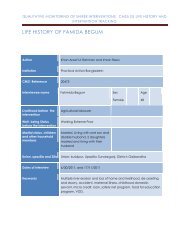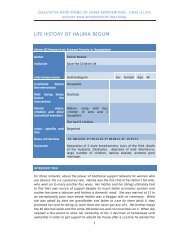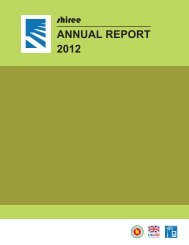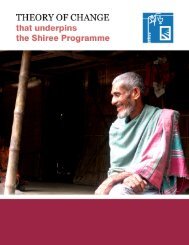qualitative monitoring of shiree interventions: cms5 (s) life histories
qualitative monitoring of shiree interventions: cms5 (s) life histories
qualitative monitoring of shiree interventions: cms5 (s) life histories
Create successful ePaper yourself
Turn your PDF publications into a flip-book with our unique Google optimized e-Paper software.
QUALITATIVE MONITORING OF SHIREE INTERVENTIONS: CMS5 (S) LIFE HISTORIES2. Mauza level: A number <strong>of</strong> villages are grouped together to form a territorial unit <strong>of</strong>jurisdiction called a mauza, <strong>of</strong> which there are more than 350 in the entire CHT. Each mauzahas a headman/woman, who is responsible for collection <strong>of</strong> revenue, preservation <strong>of</strong> peace,allocation <strong>of</strong> agricultural lands including the jums, conservation <strong>of</strong> the natural resources <strong>of</strong>the mauza and administration <strong>of</strong> customary law. They are appointed for <strong>life</strong> by the deputycommissioners in consultation with the “circle chiefs”.3. Territorial level: At the highest level it is the Raja who has authority over his/her territory.The internal matters <strong>of</strong> each village community are decided by its members, including acouncil <strong>of</strong> elders under the leadership <strong>of</strong> the Karbaris. Most matters are resolved byconsensus; if there are any disputes, the Karbari has the decisive voice. Any matters whichcannot be resolved satisfactorily, or involve members <strong>of</strong> other villages, are placed before therelevant mauza headman for decision. If required, matters are taken to the Raja, and canbe filed as a court case if necessary.Children, inheritance and new sources <strong>of</strong> incomeShaithuaung conjugal <strong>life</strong> went very well despite their poverty. In 1992, after one year <strong>of</strong>marriage, their first daughter was born. This was followed in 1995 by their first son and in 1996by a second daughter. This increased family size was a problem for the household as he wasthe only income earner; he said “I started daily labouring for the well being <strong>of</strong> my family andto feed my children. My wife couldn’t work due to our new born baby as jum cultivation ishard work”.Box 2: Jum land and cultivationJum cultivation is a traditional practice <strong>of</strong> the indigenous people <strong>of</strong> the CHTs where forest hillslopes land is cultivated on a rotational basis through a process <strong>of</strong> slashing vegetation andburning the land before cultivation.Jum cultivation is labour intensive and begins most <strong>of</strong>ten in January and February with theselection <strong>of</strong> around 1-10 acres. Each plot is demarcated under the supervision <strong>of</strong> the Mouzaheadman and the immediate forest area cleared to prevent forest fires. Vegetation isslashed in March with the preservation <strong>of</strong> valuable trees which are used for shadingvegetables and for conservation. Slashed trees used for timber are left to try for around onemonth. In April jum land is burnt and the ash acts as a fertilizer. After burning the forests, landis prepared for cultivation which takes 15-20 days.









